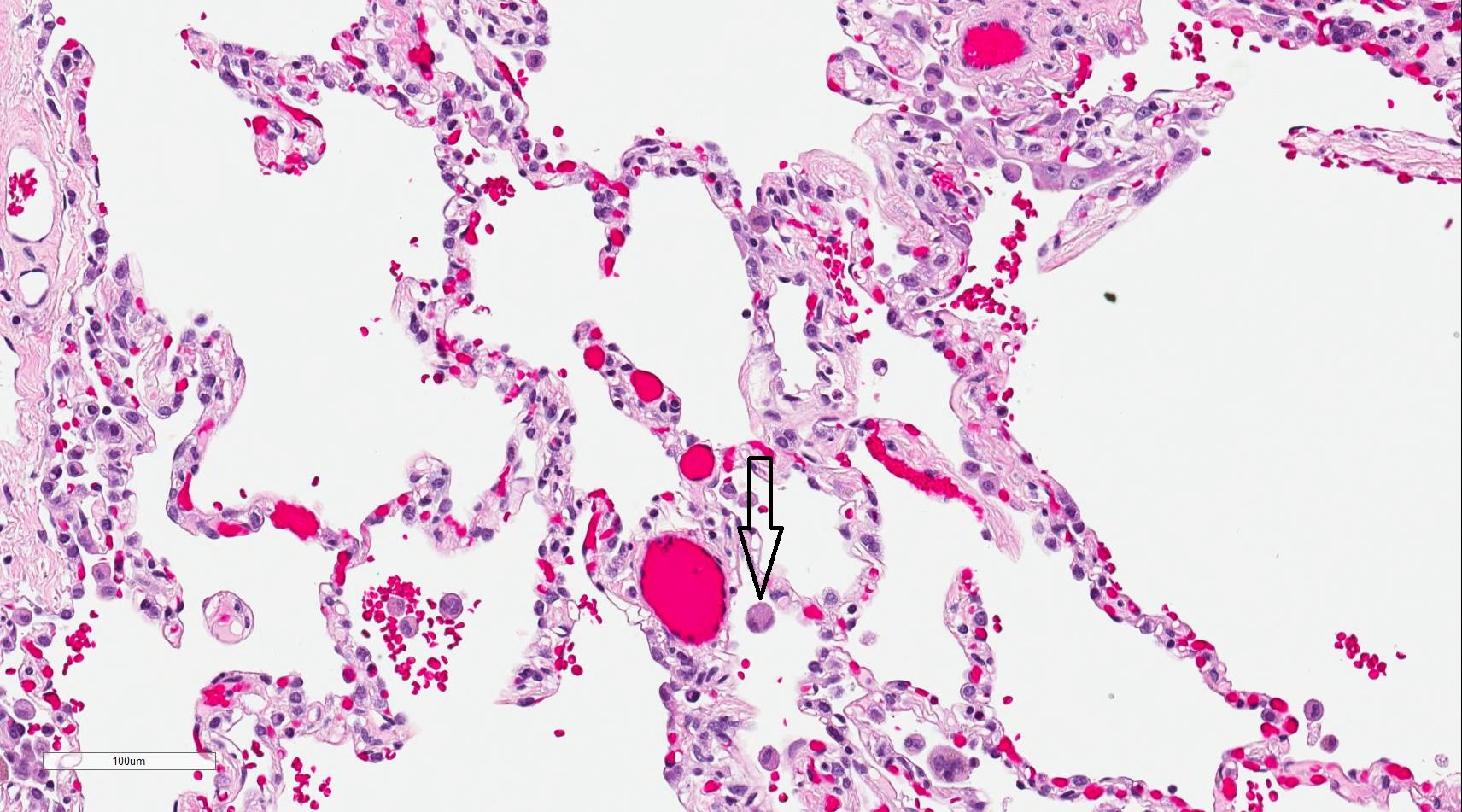[2]
Guth AM, Janssen WJ, Bosio CM, Crouch EC, Henson PM, Dow SW. Lung environment determines unique phenotype of alveolar macrophages. American journal of physiology. Lung cellular and molecular physiology. 2009 Jun:296(6):L936-46. doi: 10.1152/ajplung.90625.2008. Epub 2009 Mar 20
[PubMed PMID: 19304907]
[3]
Orkin SH. Diversification of haematopoietic stem cells to specific lineages. Nature reviews. Genetics. 2000 Oct:1(1):57-64. doi: 10.1038/35049577. Epub
[PubMed PMID: 11262875]
[4]
Martinez FO,Gordon S, The M1 and M2 paradigm of macrophage activation: time for reassessment. F1000prime reports. 2014;
[PubMed PMID: 24669294]
[5]
Mantovani A,Sozzani S,Locati M,Allavena P,Sica A, Macrophage polarization: tumor-associated macrophages as a paradigm for polarized M2 mononuclear phagocytes. Trends in immunology. 2002 Nov;
[PubMed PMID: 12401408]
[6]
Hance KA,Tataria M,Ziporin SJ,Lee JK,Thompson RW, Monocyte chemotactic activity in human abdominal aortic aneurysms: role of elastin degradation peptides and the 67-kD cell surface elastin receptor. Journal of vascular surgery. 2002 Feb;
[PubMed PMID: 11854722]
[7]
Chalifour A, Jeannin P, Gauchat JF, Blaecke A, Malissard M, N'Guyen T, Thieblemont N, Delneste Y. Direct bacterial protein PAMP recognition by human NK cells involves TLRs and triggers alpha-defensin production. Blood. 2004 Sep 15:104(6):1778-83
[PubMed PMID: 15166032]
[8]
Gulati A,Kaur D,Krishna Prasad GVR,Mukhopadhaya A, PRR Function of Innate Immune Receptors in Recognition of Bacteria or Bacterial Ligands. Advances in experimental medicine and biology. 2018;
[PubMed PMID: 30637703]
Level 3 (low-level) evidence
[9]
Haque MF,Boonhok R,Prammananan T,Chaiprasert A,Utaisincharoen P,Sattabongkot J,Palittapongarnpim P,Ponpuak M, Resistance to cellular autophagy by Mycobacterium tuberculosis Beijing strains. Innate immunity. 2015 Oct;
[PubMed PMID: 26160686]
[10]
Soufleris AJ,Pretlow TP,Bartolucci AA,Pitts AM,MacFadyen AJ,Boohaker EA,Pretlow TG 2nd, Cytologic characterization of pulmonary alveolar macrophages by enzyme histochemistry in plastic. The journal of histochemistry and cytochemistry : official journal of the Histochemistry Society. 1983 Dec;
[PubMed PMID: 6631003]
[11]
Inoue T, Plieth D, Venkov CD, Xu C, Neilson EG. Antibodies against macrophages that overlap in specificity with fibroblasts. Kidney international. 2005 Jun:67(6):2488-93
[PubMed PMID: 15882296]
[12]
Le Hir M,Kaissling B, Antibodies against macrophages that overlap in specificity with fibroblasts. Kidney international. 2005 Nov;
[PubMed PMID: 16221249]
[13]
Kunz LI,Lapperre TS,Snoeck-Stroband JB,Budulac SE,Timens W,van Wijngaarden S,Schrumpf JA,Rabe KF,Postma DS,Sterk PJ,Hiemstra PS, Smoking status and anti-inflammatory macrophages in bronchoalveolar lavage and induced sputum in COPD. Respiratory research. 2011 Mar 22;
[PubMed PMID: 21426578]
[14]
Umemura N, Saio M, Suwa T, Kitoh Y, Bai J, Nonaka K, Ouyang GF, Okada M, Balazs M, Adany R, Shibata T, Takami T. Tumor-infiltrating myeloid-derived suppressor cells are pleiotropic-inflamed monocytes/macrophages that bear M1- and M2-type characteristics. Journal of leukocyte biology. 2008 May:83(5):1136-44. doi: 10.1189/jlb.0907611. Epub 2008 Feb 19
[PubMed PMID: 18285406]
[15]
Peebles RS Jr, Aronica MA. Proinflammatory Pathways in the Pathogenesis of Asthma. Clinics in chest medicine. 2019 Mar:40(1):29-50. doi: 10.1016/j.ccm.2018.10.014. Epub
[PubMed PMID: 30691715]
[16]
Ufimtseva E,Eremeeva N,Bayborodin S,Umpeleva T,Vakhrusheva D,Skornyakov S, Mycobacterium tuberculosis with different virulence reside within intact phagosomes and inhibit phagolysosomal biogenesis in alveolar macrophages of patients with pulmonary tuberculosis. Tuberculosis (Edinburgh, Scotland). 2019 Jan;
[PubMed PMID: 30711161]
[17]
Gutierrez MG,Master SS,Singh SB,Taylor GA,Colombo MI,Deretic V, Autophagy is a defense mechanism inhibiting BCG and Mycobacterium tuberculosis survival in infected macrophages. Cell. 2004 Dec 17;
[PubMed PMID: 15607973]
[18]
Mohan A, Malur A, McPeek M, Barna BP, Schnapp LM, Thomassen MJ, Gharib SA. Transcriptional survey of alveolar macrophages in a murine model of chronic granulomatous inflammation reveals common themes with human sarcoidosis. American journal of physiology. Lung cellular and molecular physiology. 2018 Apr 1:314(4):L617-L625. doi: 10.1152/ajplung.00289.2017. Epub 2017 Dec 6
[PubMed PMID: 29212802]
Level 3 (low-level) evidence
[19]
Mortaz E,Masjedi MR,Abedini A,Matroodi S,Kiani A,Soroush D,Adcock IM, Common features of tuberculosis and sarcoidosis. International journal of mycobacteriology. 2016 Dec;
[PubMed PMID: 28043581]
[20]
Koyama S,Sato E,Haniuda M,Numanami H,Nagai S,Izumi T, Decreased level of vascular endothelial growth factor in bronchoalveolar lavage fluid of normal smokers and patients with pulmonary fibrosis. American journal of respiratory and critical care medicine. 2002 Aug 1;
[PubMed PMID: 12153975]
[21]
Lee KH,Jeong J,Koo YJ,Jang AH,Lee CH,Yoo CG, Exogenous neutrophil elastase enters bronchial epithelial cells and suppresses cigarette smoke extract-induced heme oxygenase-1 by cleaving sirtuin 1. The Journal of biological chemistry. 2017 Jul 14;
[PubMed PMID: 28588027]
[22]
Lee KH, Lee J, Jeong J, Woo J, Lee CH, Yoo CG. Cigarette smoke extract enhances neutrophil elastase-induced IL-8 production via proteinase-activated receptor-2 upregulation in human bronchial epithelial cells. Experimental & molecular medicine. 2018 Jul 6:50(7):1-9. doi: 10.1038/s12276-018-0114-1. Epub 2018 Jul 6
[PubMed PMID: 29980681]

